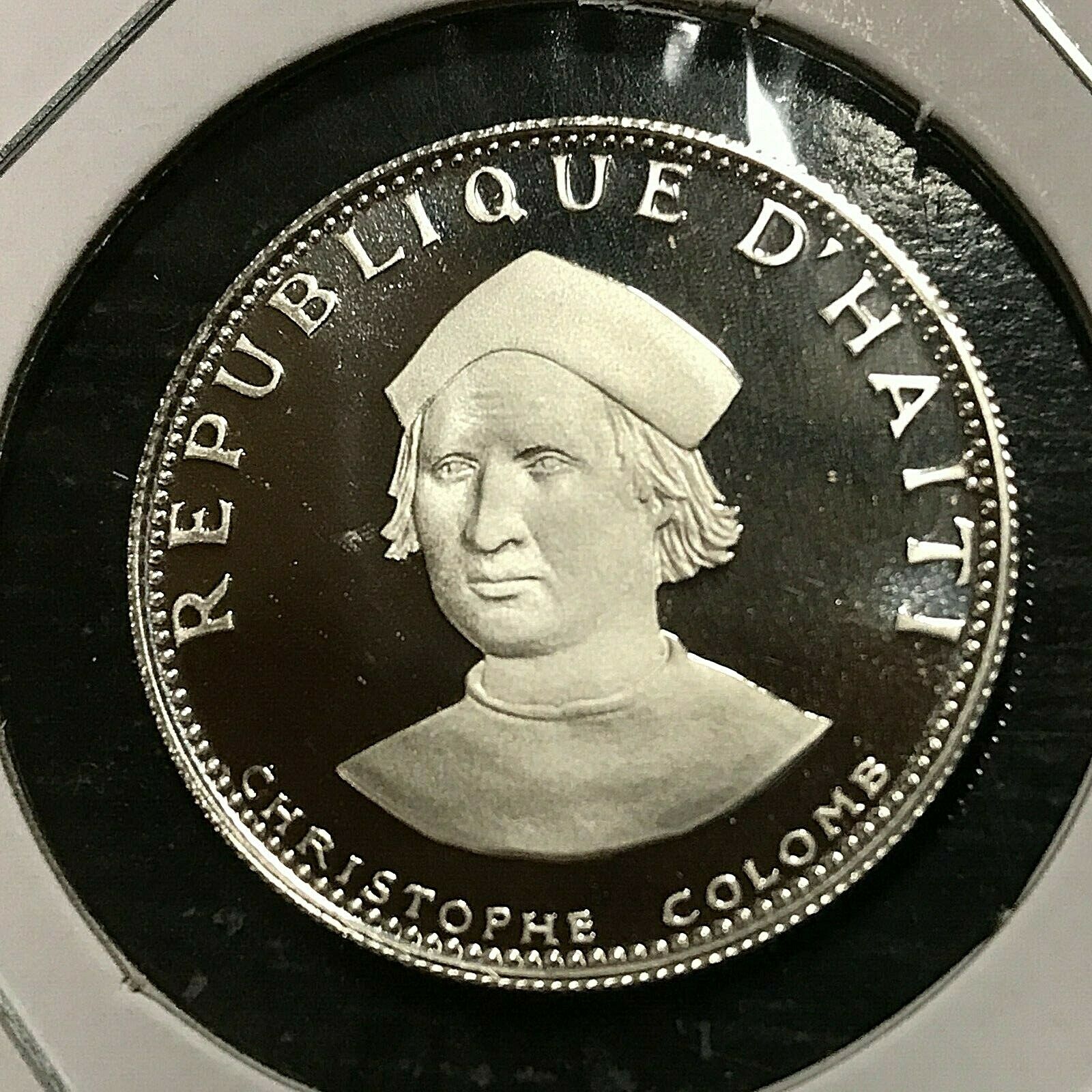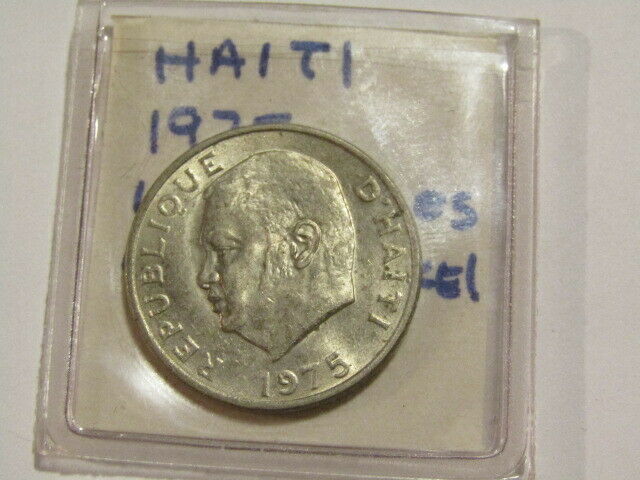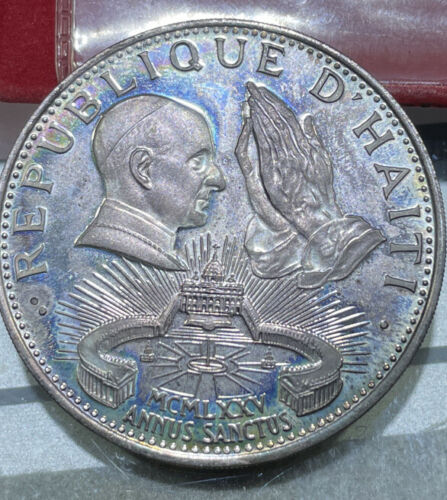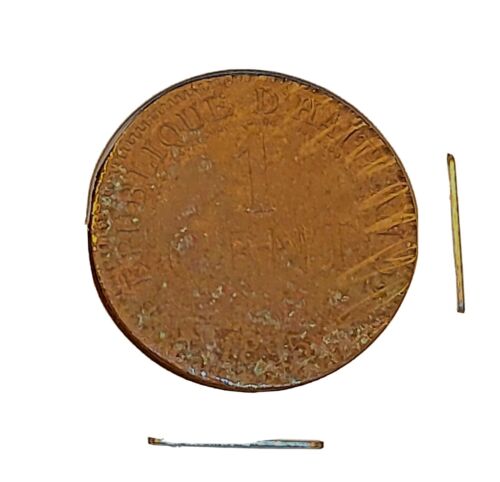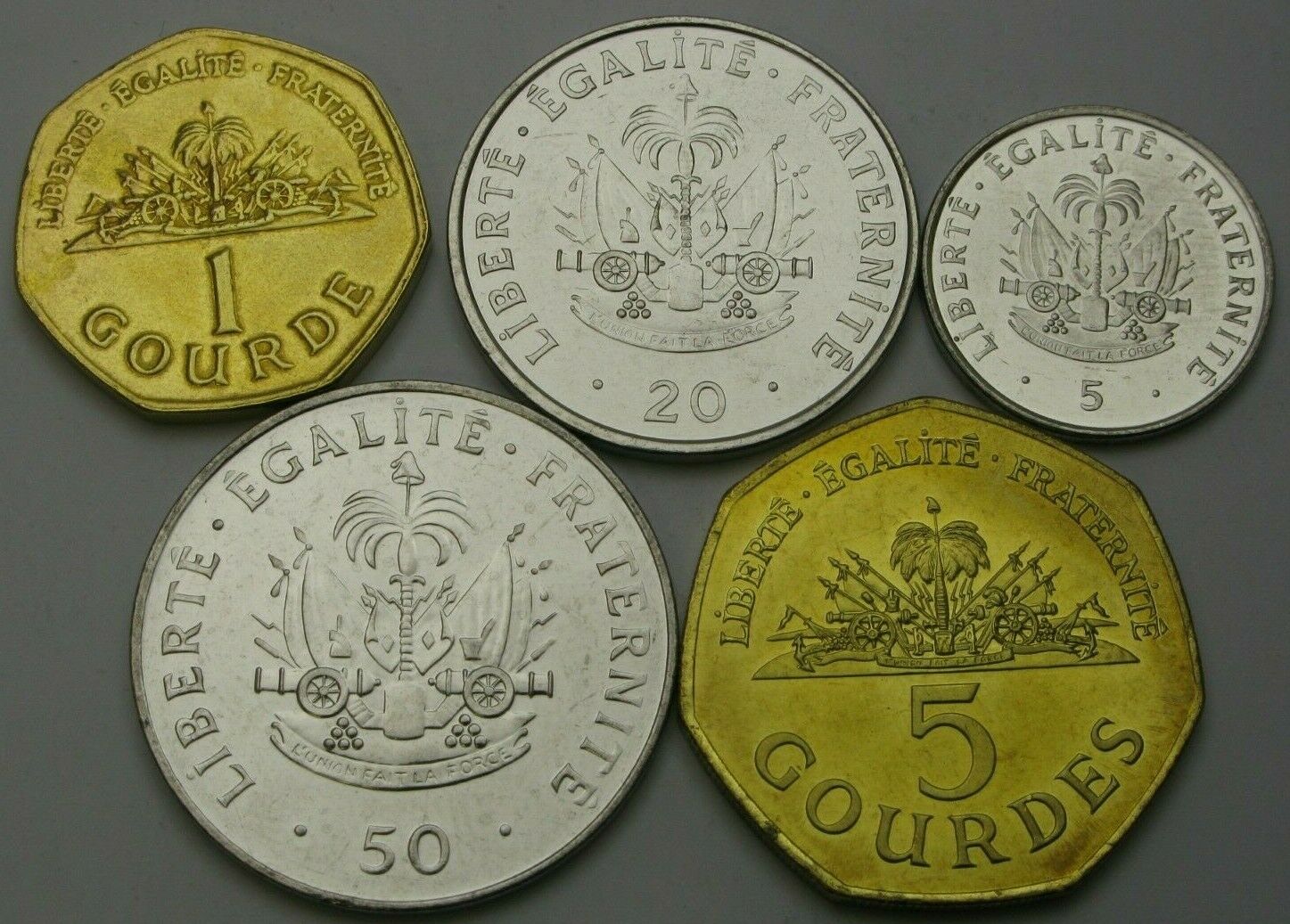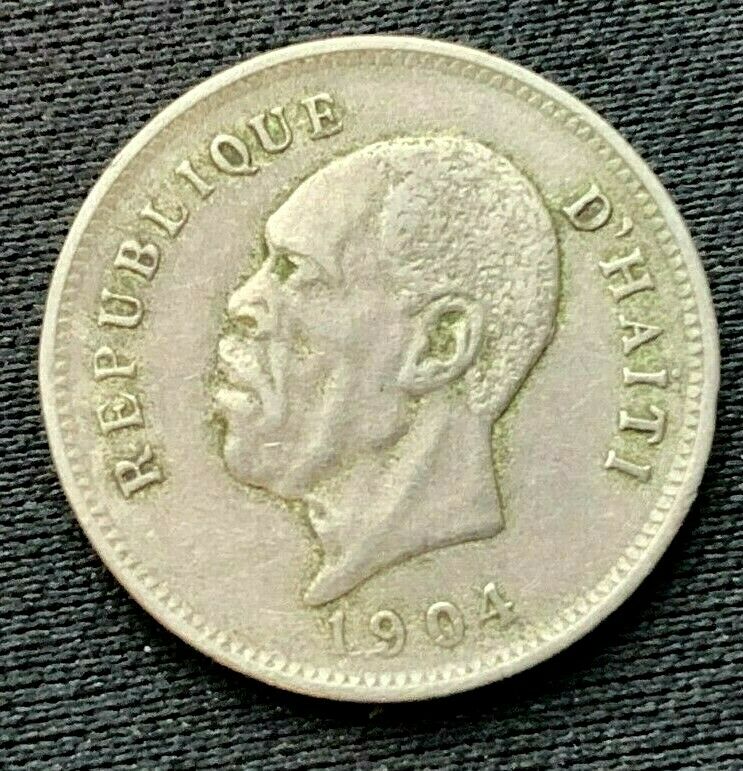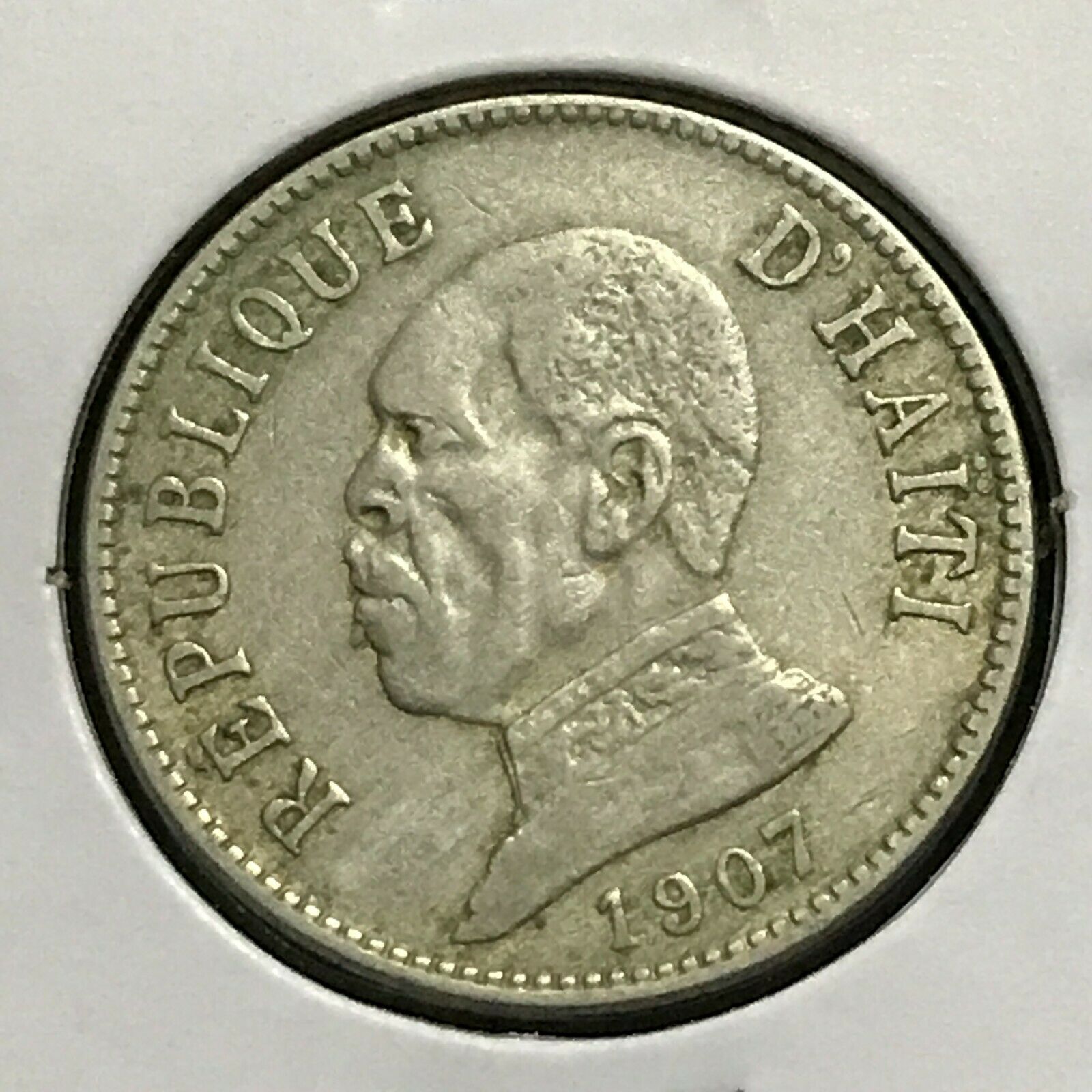-40%
1863 REPUBLIQUE D'HAITI 10 DIX CENTIME COIN REPUBLIC HAITI KM40 US CIVIL WAR ERA
$ 47.52
- Description
- Size Guide
Description
SquareTrade © AP6.01863 REPUBLIQUE D'HAITI 10 DIX CENTIME COIN REPUBLIC HAITI KM40 US CIVIL WAR ERA
GREETINGS, FEEL FREE
TO
"SHOP NAKED."
©
We deal in items we believe others will enjoy and want to purchase.
We are not experts.
We welcome any comments, questions, or concerns.
WE ARE TARGETING A GLOBAL MARKET PLACE.
Thanks in advance for your patronage.
Please Be sure to add WDG to your
favorites list
!
NOW FOR YOUR VIEWING PLEASURE…
REPUBLIC OF HAITI
1863
(10) DIX CENTIMES
KM# 40
23mm
4g
BRONZE
FACE: PRESIDENT GEFFRAND
OBVERSE: COAT OF ARMS
XF
KEY DATE
DURING UNITED STATES CIVIL WAR ERA
NUMISMATIC RARITY ~ 87
CRISP!
----------------------------------------------
FYI
Haiti, officially the Republic of Haiti (République d'Haïti; Repiblik Ayiti), is a Caribbean country. It occupies the western, smaller portion of the island of Hispaniola, in the Greater Antillean archipelago, which it shares with the Dominican Republic. Ayiti (land of high mountains) was the indigenous Taíno or Amerindian name for the island. The country's highest point is Pic la Selle, at 2,680 metres (8,793 ft). The total area of Haiti is 27,750 square kilometres (10,714 sq mi) and its capital is Port-au-Prince. Haitian Creole and French are the official languages.
Haiti's regional, historical, and ethno-linguistic position is unique for several reasons. It was the first independent nation of Latin America and the Caribbean, the first black-led republic in the world, and the second republic in the Americas when it gained independence in 1804 as part of a successful slave revolution lasting nearly a decade. In 2012, Haiti announced its intention to seek associate membership status in the African Union. Haiti is the only predominantly Francophone independent nation in the Americas. It is one of only two independent nations in the Americas (along with Canada) to designate French as an official language; the other French-speaking areas are all overseas départements, or collectivités, of France.
Haiti is the most populous full member-state of the Caribbean Community (CARICOM)-bloc. It is the poorest country in the Americas as per the Human Development Index. Political violence has occurred regularly throughout its history, leading to government instability. Most recently, in February 2004, a coup d'état originating in the north of the country forced the resignation and exile of President Jean-Bertrand Aristide. A provisional government took control with security provided by the United Nations Stabilization Mission in Haiti (MINUSTAH). Michel Martelly, the current president, was elected in the Haitian general election, 2011.
The island has had a history of destructive earthquakes. A 7.0 magnitude earthquake struck Haiti on 12 January 2010 and devastated Port-au-Prince. The highest reliable death count was estimated at 220,000. Haitian government estimates were higher. The Presidential palace, Parliament and many other important structures were destroyed, along with countless homes and businesses, leaving hundreds of thousands of people homeless. The country has yet to recover from the 2010 earthquake (and subsequent incidents) due to both the severity of the damage Haiti endured in 2010, as well as a government that was ineffective well before the earthquake. United States aid organizations have donated billion. Combined with other international donations, these funds are intended to contribute to the rebuilding of the country.
Beginning in 1821, President Jean Pierre Boyer, also an homme de couleur and successor to Pétion, managed to reunify the two parts of St. Domingue and extend control over the western part of the island. In addition, after Santo Domingo declared its independence from Spain, Boyer sent forces in to take control. Boyer then ruled the entire island. According to Encyclopædia Britannica, "During his presidency, Boyer tried to halt the downward trend of the economy – which had begun with the successful revolt of black slaves against their French masters in the 1790s – by passing the Code Rural. Its provisions sought to tie the peasant labourers to plantation land by denying them the right to leave the land, enter the towns, or start farms or shops of their own and by creating a rural constabulary to enforce the code."
During Boyer's administration, his government negotiated with Loring D. Dewey, an agent of the American Colonization Society (ACS), to encourage free blacks from the United States to emigrate to Haiti. They hoped to gain people with skills to contribute to the independent nation. In the early 19th century, the ACS – an uneasy blend of abolitionists and slaveholders – proposed resettlement of American free blacks to other countries, primarily to a colony in Liberia, as a solution to problems of racism in the US. Starting in September 1824, more than 6,000 American free blacks migrated to Haiti, with transportation paid by the ACS. Due to the poverty and other difficult conditions there, many returned to the US within a short time.
In July 1825, King Charles X of France sent a fleet of 14 vessels and thousands of troops to reconquer the island. Under pressure, President Boyer agreed to a treaty by which France formally recognized the independence of the nation in exchange for a payment of 150 million francs (reduced to 90 million in 1838) – an indemnity for profits lost from the slave trade. French abolitionist Victor Schoelcher wrote, "Imposing an indemnity on the victorious slaves was equivalent to making them pay with money that which they had already paid with their blood."
After losing the support of Haiti's elite, Boyer was ousted in 1843. A long succession of coups followed his departure to exile. National authority was disputed by factions of the army, the elite class, and the growing commercial class, increasingly made up of numerous immigrant businessmen: Germans, Americans, French and English.
In 1912, Syrians residing in Haiti participated in a plot in which the Presidential Palace was destroyed. On more than one occasion, French, US, German and British forces allegedly claimed large sums of money from the vaults of the National Bank of Haiti. Expatriates bankrolled and armed opposing groups.
In addition, national governments intervened in Haitian affairs. In 1892, the German government supported suppression of the reform movement of Anténor Firmin. In January 1914, British, German and US forces entered Haiti, ostensibly to protect their citizens from civil unrest.
United States occupation of Haiti (1915–1934)
In an expression of the Roosevelt Corollary to the Monroe Doctrine, the United States occupied the island in 1915 and US Marines were stationed in the country until 1934. According to Monroe, treaties in 1915 and 1917 gave the U.S. State and Navy departments (and the Navy's Marine Corps) effective control over key government roles; the U.S. assumed responsibility for maintaining domestic peace and put down several small rebellions such as the "Cacos" uprising. Haiti had huge debts, which were refinanced by new loans from the National City Bank of New York, and paid off by American government officials who took control of customs and the national budget. The U.S. transformed the Garde into a modern police force and built up advanced public health, education, ports and roads.
According to Paul Farmer, the US administration dismantled the constitutional system, reinstituted virtual slavery for building roads, and established the National Guards that ran the country by violence and terror after the Marines left. It also made massive improvements to infrastructure: 1,700 kilometres (1,100 mi) of roads were made usable; 189 bridges were built; many irrigation canals were rehabilitated; hospitals, schools, and public buildings were constructed, and drinking water was brought to the main cities. Sisal was introduced to Haiti, and sugar and cotton became significant exports. The U.S. Marines supervised the operations of a client Haitian government, and emphasized American-style modernization of the infrastructure and universal education. Haitian traditionalists were highly resistant to these changes while the urban elites wanted more control. Together they helped force an end to the occupation in 1934. President Herbert Hoover sent a commission that set up a plan of withdrawal that was achieved under President Franklin D. Roosevelt. The first step was a gradual, systematic turnover of government functions to the Haitian government; in 1934 it took control of the Garde and the Marines departed. The debts were still outstanding and the American financial advisor-general receiver handled the budget until 1941.
In 1915, Philippe Sudré Dartiguenave was elected president. He was succeeded by Louis Borno in the 1922 elections. Borno worked closely with the Americans. Aware that many Haitians did not speak French, he was the first president to authorize the use of Creole in the education system. Sisal fiber cultivation was introduced to Haiti, and sugar and cotton became significant exports. Recognition of the distinctive traditionalism of the Haitian people had a sharp impact on black writers in the U.S. (as well as white writers exploring black themes), including Eugene O'Neill, James Weldon Johnson, Langston Hughes, Zora Neale Hurston and Orson Welles.
End of US occupation until election of Duvalier (1934–1956)
The US occupation forces established a boundary between Haiti and the Dominican Republic by taking disputed land from the latter. After the US left in 1934, Dominican dictator Rafael Trujillo – in an event known as the Parsley Massacre – ordered his Army to kill Haitians living on the Dominican side of the border. In a "three-day genocidal spree", he murdered between 10,000 and 20,000 Haitians. He then developed a uniquely Dominican policy of racial discrimination, Antihaitianismo ("anti-Haitianism"), targeting the mostly black inhabitants of his neighboring country.
Sténio Vincent was succeeded as President in 1941 by Élie Lescot. In 1949, Lescot tried to change the constitution to allow for his own reelection, but in 1950 this triggered another coup. General Paul Magloire led the country until December 1956, when he was forced to resign by a general strike. After a period of disorder, an election held in September 1957 saw Dr. François Duvalier elected President.
(THIS PICTURE FOR DISPLAY ONLY)
---------------------------
Thanks for choosing this auction. You may email for alternate payment arrangements. We combine shipping. Please pay promptly after the auction. The item will be shipped upon receipt of funds. WE ARE GOING GREEN, SO WE DO SOMETIMES USE CLEAN RECYCLED MATERIALS TO SHIP.
Please leave feedback when you have received the item and are satisfied. Please respond when you have received the item * If you were pleased with this transaction, please respond with all 5 stars! If you are not pleased, let us know via e-mail. Our goal is for 5-star service. We want you to be a satisfied, return customer.
Please express any concerns or questions. More pictures are available upon request. The winning bid will incur the cost of S/H INSURED FEDEX OR USPS. See rate calculator or email FOR ESTIMATE. International Bidders are Welcome but be mindful if your country is excluded from safe shipping.
Thanks for perusing
THIS
and
ALL
our auctions.
Please Check out our
other items
!
WE like the curious and odd.
BUY, BYE!!
i
Track Page Views With
Auctiva's FREE Counter



